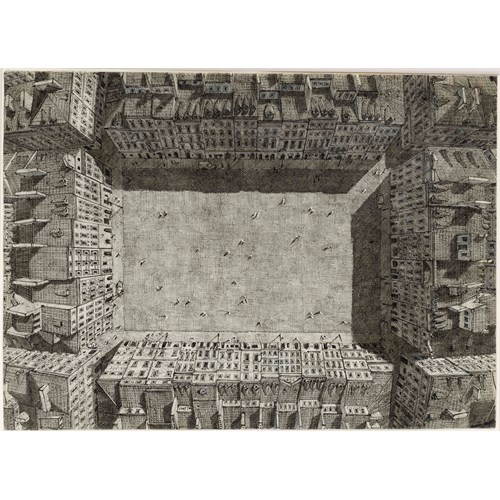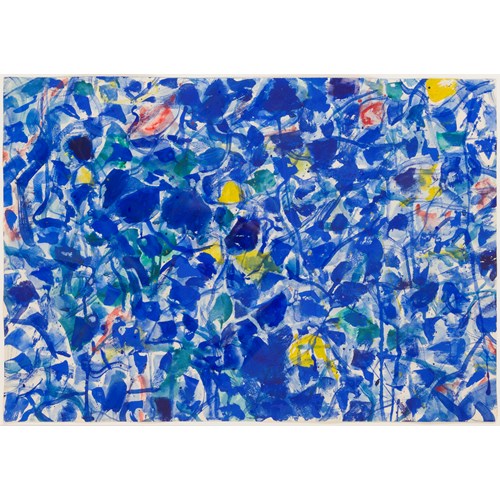Marketplace
Letter to Viola Rackow, with a Still Life of a Champagne Cork and a Cigarette Butt
Horst JANSSEN
Letter to Viola Rackow, with a Still Life of a Champagne Cork and a Cigarette Butt
Medium Pencil and coloured chalks on buff paper
Dimension 26.1 x 24.1 cm (10¹/₄ x 9¹/₂ inches)
The text of this letter to the artist’s lover Viola Rackow, whom he often referred to by the nickname ‘Vriedrich’, may be loosely translated as follows:
‘Dear Vriedrich,
You still haven’t understood me: The only thing that you have to say to me, with your keys in your hand while you snatch me out of my meagre sleep, is “the children are so disappointed - I will not do this again”.
That is so disgustingly egocentric and so unfair - it could be from me.
Runge.’
Horst Janssen’s love affair with Viola Rackow (b.1941) resulted in a long friendship and correspondence, with the artist sending her numerous illustrated letters. In many of these letters, such as the present sheet, the artist addresses Viola as ‘Vriederich’ or ‘Vriedrich’ and signs himself as ‘Runge’. This stems from the fact that Janssen often went to see the important group of paintings by the German Romantic artists Philipp Otto Runge and Caspar David Friedrich in the collection of the Kunsthalle in Hamburg. His obsession with these works resulted in Viola’s once jokingly referring to him as ‘Runge’, to which Janssen responded by calling her ‘Vriederich’ (with a V for Viola instead of an F), and it seems that both nicknames stuck.
As Jutta Siegmund-Schultze has noted, ‘As can be learned from the letters, Horst Janssen loved Viola – ‘your agility, your verve, your serenity + nimbleness’ or, as it says in a beautiful folk-song-like passage: ‘...I love you / I love your little face / I love you / I love your sweet little face / I love you /I love your body / excessively. / YES’. But the other side of the coin is: ‘You are still too young for me in your development. You do not yet have a relationship with the painfulness of life…’ [or] ‘I love you and it is hopeless for my longing.’ Conclusion: ‘You’re a pretty tough cookie, and I love you very much.’ In this relationship, in which Janssen, perhaps for the first time, not only has a loving, tender woman, but also a worthy opponent, it goes without saying that sometimes the sparks fly, that fights are called for, that jealousy and misunderstandings accumulate, which cannot be avoided given the equally distributed temperament of the two. But it's also touching to read how Janssen keeps trying to understand and educate Viola, to clear up these damned misunderstandings and put things in order, especially with himself, and to find the serenity that he so desperately needs and which means the truth to him. These letters to Viola are not only the very personal testimony of a love between two extraordinary people, they also provide an insight into the life of one of the greatest artists of our time, into his struggles against himself and his ailing body, into his longings and fears, which always revolve around creativity and the end of everything, death, and for which, just as much as for his joy on a beautiful morning, he needs his beloved to listen and to be ‘at peace’ with everything.’
Pencil and coloured chalks on buff paper; the sheet torn at the lower right corner.
Dated and inscribed 14 / 7 / 77 730 / Lieb Vriederich / du hast mich immer noch nicht begriffen: / das einzigewas du mir zu sagen hast, / während du mit deinem Schlüssel in der / Hand mich aus dem wenigsten schlaf reisst, / ist: “die Kinder sind so enttäuscht – ich tu / das nicht wieder”. / das ist so widerlich egozentrisch / + so unfair – es Könnte von mir sein. / Runge. at the bottom half of the sheet.
‘Dear Vriedrich,
You still haven’t understood me: The only thing that you have to say to me, with your keys in your hand while you snatch me out of my meagre sleep, is “the children are so disappointed - I will not do this again”.
That is so disgustingly egocentric and so unfair - it could be from me.
Runge.’
Horst Janssen’s love affair with Viola Rackow (b.1941) resulted in a long friendship and correspondence, with the artist sending her numerous illustrated letters. In many of these letters, such as the present sheet, the artist addresses Viola as ‘Vriederich’ or ‘Vriedrich’ and signs himself as ‘Runge’. This stems from the fact that Janssen often went to see the important group of paintings by the German Romantic artists Philipp Otto Runge and Caspar David Friedrich in the collection of the Kunsthalle in Hamburg. His obsession with these works resulted in Viola’s once jokingly referring to him as ‘Runge’, to which Janssen responded by calling her ‘Vriederich’ (with a V for Viola instead of an F), and it seems that both nicknames stuck.
As Jutta Siegmund-Schultze has noted, ‘As can be learned from the letters, Horst Janssen loved Viola – ‘your agility, your verve, your serenity + nimbleness’ or, as it says in a beautiful folk-song-like passage: ‘...I love you / I love your little face / I love you / I love your sweet little face / I love you /I love your body / excessively. / YES’. But the other side of the coin is: ‘You are still too young for me in your development. You do not yet have a relationship with the painfulness of life…’ [or] ‘I love you and it is hopeless for my longing.’ Conclusion: ‘You’re a pretty tough cookie, and I love you very much.’ In this relationship, in which Janssen, perhaps for the first time, not only has a loving, tender woman, but also a worthy opponent, it goes without saying that sometimes the sparks fly, that fights are called for, that jealousy and misunderstandings accumulate, which cannot be avoided given the equally distributed temperament of the two. But it's also touching to read how Janssen keeps trying to understand and educate Viola, to clear up these damned misunderstandings and put things in order, especially with himself, and to find the serenity that he so desperately needs and which means the truth to him. These letters to Viola are not only the very personal testimony of a love between two extraordinary people, they also provide an insight into the life of one of the greatest artists of our time, into his struggles against himself and his ailing body, into his longings and fears, which always revolve around creativity and the end of everything, death, and for which, just as much as for his joy on a beautiful morning, he needs his beloved to listen and to be ‘at peace’ with everything.’
Pencil and coloured chalks on buff paper; the sheet torn at the lower right corner.
Dated and inscribed 14 / 7 / 77 730 / Lieb Vriederich / du hast mich immer noch nicht begriffen: / das einzigewas du mir zu sagen hast, / während du mit deinem Schlüssel in der / Hand mich aus dem wenigsten schlaf reisst, / ist: “die Kinder sind so enttäuscht – ich tu / das nicht wieder”. / das ist so widerlich egozentrisch / + so unfair – es Könnte von mir sein. / Runge. at the bottom half of the sheet.
Medium: Pencil and coloured chalks on buff paper
Dimension: 26.1 x 24.1 cm (10¹/₄ x 9¹/₂ inches)
Provenance: Viola Rackow, Hamburg
By descent to Nicolaus Rackow, Eppendorf, Hamburg.
Literature: Horst Janssen, Vriederich: Briefe an Viola, Hamburg, 1986, illustrated p.21.
More artworks from the Gallery









